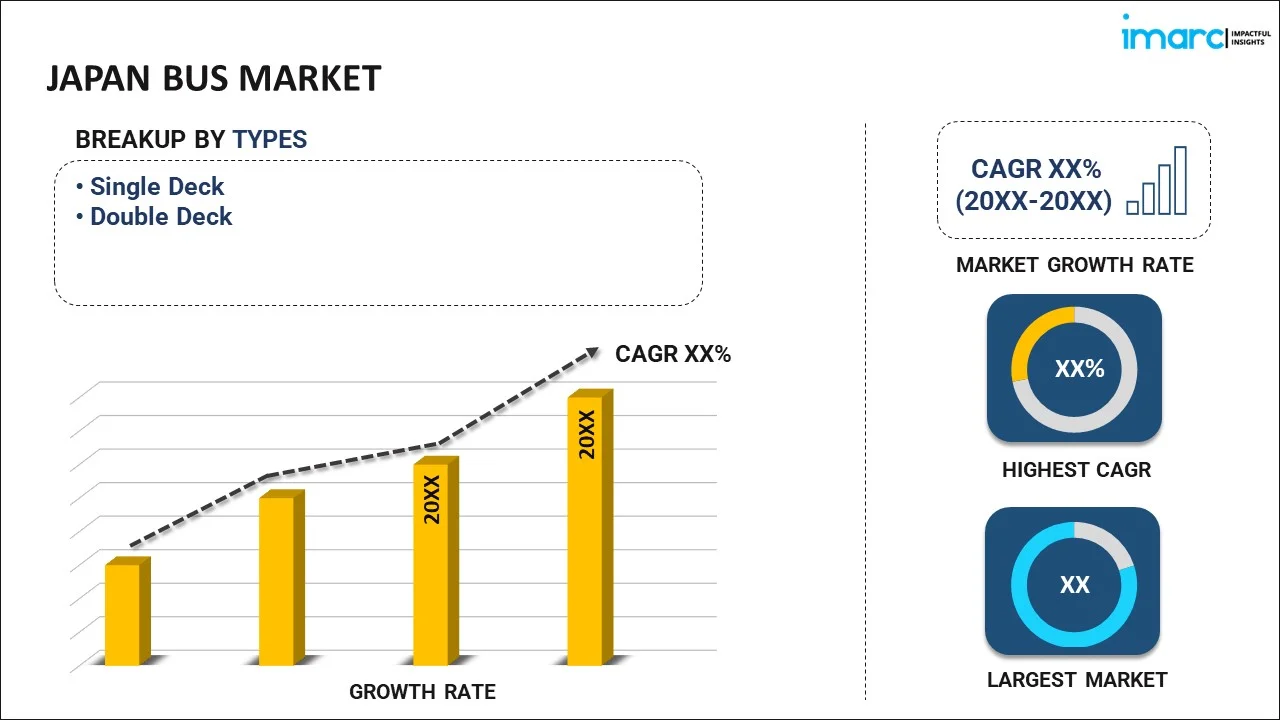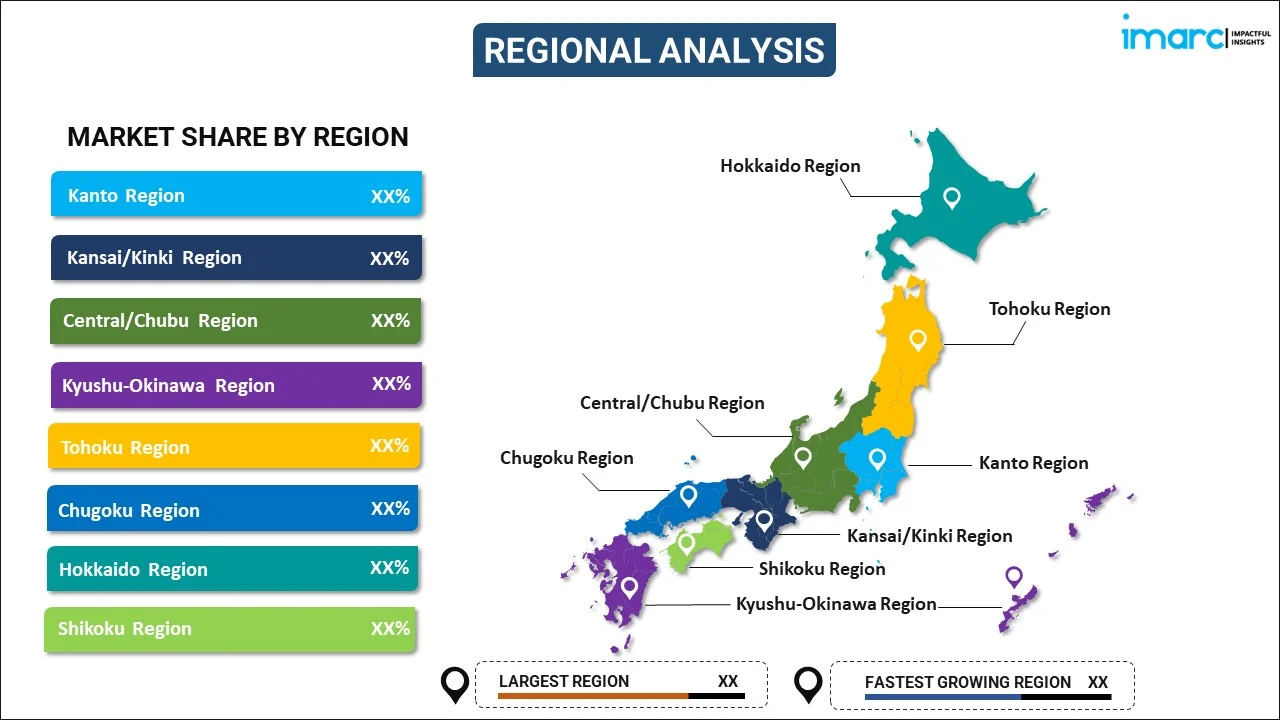
Japan Bus Market Report by Type (Single Deck, Double Deck), Fuel Type (Diesel, Electric and Hybrid, and Others), Seat Capacity (15-30 Seats, 31-50 Seats, More Than 50 Seats), Application (Transit Bus, Intercity/Coaches, and Others), and Region 2025-2033
Market Overview:
Japan bus market size reached USD 3,158 Million in 2024. Looking forward, IMARC Group expects the market to reach USD 3,513 Million by 2033, exhibiting a growth rate (CAGR) of 1.2% during 2025-2033. The increasing advances in technology, such as electric propulsion systems, autonomous driving capabilities, and improved passenger amenities, that can drive innovation and growth in the bus industry, are primarily driving the market.
|
Report Attribute
|
Key Statistics
|
|---|---|
|
Base Year
|
2024
|
|
Forecast Years
|
2025-2033
|
|
Historical Years
|
2019-2024
|
|
Market Size in 2024
|
USD 3,158 Million |
|
Market Forecast in 2033
|
USD 3,513 Million |
| Market Growth Rate 2025-2033 | 1.2% |
Buses are an integral part of daily lives, serving as a convenient and eco-friendly mode of transportation in many parts of the region. These large vehicles are designed to carry multiple passengers, making them a cost-effective solution for commuting within cities and for long-distance travel. Buses come in various shapes and sizes, from compact city buses to luxurious coaches for intercity and cross-country journeys. They offer a viable alternative to private cars, helping reduce traffic congestion and environmental pollution. Moreover, buses provide accessibility to individuals who may not have access to personal vehicles, promoting inclusivity in transportation. Inside a bus, passengers find comfortable seating, safety features, and often, amenities like air conditioning and Wi-Fi. Friendly bus drivers or automated systems ensure a smooth and reliable journey. Whether heading to work, school, or embarking on a scenic adventure, buses are a dependable means of getting from point A to point B, fostering connectivity and community as they roll along the road.
Japan Bus Market Trends:
The bus market in Japan is influenced by a myriad of factors, with several key drivers shaping its dynamics. Firstly, urbanization continues to be a primary force propelling the demand for buses. As cities expand and populations grow, there is an increasing need for efficient and sustainable public transportation solutions. Furthermore, the rising awareness of environmental concerns and the need for eco-friendly transportation options are significant contributors. Consequently, governments and regulatory bodies in Japan are implementing stringent emission norms, compelling bus manufacturers to innovate and produce greener, electric, or hybrid bus models. Moreover, economic factors like fuel prices and the overall cost of ownership drive fleet operators to explore fuel-efficient and cost-effective bus solutions. Apart from this, the ongoing advancements in technology, like the integration of smart features such as GPS tracking, Wi-Fi connectivity, and real-time passenger information systems, which enhance the overall appeal of buses, making them more attractive to commuters, are expected to drive the bus market in Japan.
Japan Bus Market Segmentation:
IMARC Group provides an analysis of the key trends in each segment of the market, along with forecasts at the country level for 2025-2033. Our report has categorized the market based on type, fuel type, seat capacity, and application.
Type Insights:

- Single Deck
- Double Deck
The report has provided a detailed breakup and analysis of the market based on the type. This includes single deck and double deck.
Fuel Type Insights:
- Diesel
- Electric and Hybrid
- Others
A detailed breakup and analysis of the market based on the fuel type have also been provided in the report. This includes diesel, electric and hybrid, and others.
Seat Capacity Insights:
- 15-30 Seats
- 31-50 Seats
- More Than 50 Seats
The report has provided a detailed breakup and analysis of the market based on the seat capacity. This includes 15-30 seats, 31-50 seats, and more than 50 seats.
Application Insights:
- Transit Bus
- Intercity/Coaches
- Others
A detailed breakup and analysis of the market based on the application have also been provided in the report. This includes transit bus, intercity/coaches, and others.
Regional Insights:

- Kanto Region
- Kansai/Kinki Region
- Central/ Chubu Region
- Kyushu-Okinawa Region
- Tohoku Region
- Chugoku Region
- Hokkaido Region
- Shikoku Region
The report has also provided a comprehensive analysis of all the major regional markets, which include Kanto Region, Kansai/Kinki Region, Central/ Chubu Region, Kyushu-Okinawa Region, Tohoku Region, Chugoku Region, Hokkaido Region, and Shikoku Region.
Competitive Landscape:
The market research report has also provided a comprehensive analysis of the competitive landscape. Competitive analysis such as market structure, key player positioning, top winning strategies, competitive dashboard, and company evaluation quadrant has been covered in the report. Also, detailed profiles of all major companies have been provided. Some of the key players include:
- BYD Company Ltd.
- Isuzu Motors Ltd.
- IVECO S.p.A. (Iveco Group NV)
- Mitsubishi Fuso Truck and Bus Corporation
(Please note that this is only a partial list of the key players, and the complete list is provided in the report.)
Japan Bus Market Report Coverage:
| Report Features | Details |
|---|---|
| Base Year of the Analysis | 2024 |
| Historical Period | 2019-2024 |
| Forecast Period | 2025-2033 |
| Units | Million USD |
| Scope of the Report | Exploration of Historical and Forecast Trends, Industry Catalysts and Challenges, Segment-Wise Historical and Predictive Market Assessment:
|
| Types Covered | Single Deck, Double Deck |
| Fuel Types Covered | Diesel, Electric and Hybrid, Others |
| Seat Capacities Covered | 15-30 Seats, 31-50 Seats, More Than 50 Seats |
| Applications Covered | Transit Bus, Intercity/Coaches, Others |
| Regions Covered | Kanto Region, Kansai/Kinki Region, Central/ Chubu Region, Kyushu-Okinawa Region, Tohoku Region, Chugoku Region, Hokkaido Region, Shikoku Region |
| Companies Covered | BYD Company Ltd., Isuzu Motors Ltd., IVECO S.p.A. (Iveco Group NV), Mitsubishi Fuso Truck and Bus Corporation, etc. |
| Customization Scope | 10% Free Customization |
| Post-Sale Analyst Support | 10-12 Weeks |
| Delivery Format | PDF and Excel through Email (We can also provide the editable version of the report in PPT/Word format on special request) |
Key Questions Answered in This Report:
- How has the Japan bus market performed so far and how will it perform in the coming years?
- What has been the impact of COVID-19 on the Japan bus market?
- What is the breakup of the Japan bus market on the basis of type?
- What is the breakup of the Japan bus market on the basis of fuel type?
- What is the breakup of the Japan bus market on the basis of seat capacity?
- What is the breakup of the Japan bus market on the basis of application?
- What are the various stages in the value chain of the Japan bus market?
- What are the key driving factors and challenges in the Japan bus?
- What is the structure of the Japan bus market and who are the key players?
- What is the degree of competition in the Japan bus market?
Key Benefits for Stakeholders:
- IMARC’s industry report offers a comprehensive quantitative analysis of various market segments, historical and current market trends, market forecasts, and dynamics of the Japan bus market from 2019-2033.
- The research report provides the latest information on the market drivers, challenges, and opportunities in the Japan bus market.
- Porter's five forces analysis assist stakeholders in assessing the impact of new entrants, competitive rivalry, supplier power, buyer power, and the threat of substitution. It helps stakeholders to analyze the level of competition within the Japan bus industry and its attractiveness.
- Competitive landscape allows stakeholders to understand their competitive environment and provides an insight into the current positions of key players in the market.
Need more help?
- Speak to our experienced analysts for insights on the current market scenarios.
- Include additional segments and countries to customize the report as per your requirement.
- Gain an unparalleled competitive advantage in your domain by understanding how to utilize the report and positively impacting your operations and revenue.
- For further assistance, please connect with our analysts.
 Inquire Before Buying
Inquire Before Buying
 Speak to an Analyst
Speak to an Analyst
 Request Brochure
Request Brochure
 Request Customization
Request Customization




.webp)




.webp)












